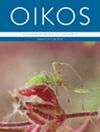圭亚那屏蔽区热带森林细根生物量和性状对大规模氮磷添加的不同反应
IF 3.1
2区 环境科学与生态学
Q2 ECOLOGY
引用次数: 0
摘要
细根是植物获取养分和生长的媒介。根据土壤养分的可用性,植物可以调节细根的生物量和形态特征,以优化养分获取。然而,人们对这些参数影响森林功能的重要性知之甚少。在这项研究中,我们测量了根系对养分添加的反应,以从机理上了解法属圭亚那两片热带森林中植物对养分限制的适应情况,这两片森林的土壤养分状况相差两倍。我们分析了添加氮和磷三年后根系生物量、平均根直径(RD)、比根长度(SRL)、比根面积(SRA)、根组织密度(RTD)以及根部至 15 厘米土壤深度的碳(C)、氮(N)和磷(P)浓度的反应。在肥力较低的帕拉库(Paracou)地区,无论添加氮还是磷,根的生物量或形态特征都没有发生变化,但根中的磷浓度随着磷的添加而增加。在肥力较高的诺拉盖斯,根的生物量和根中的钾浓度随着钾的添加而增加,但形态特征没有变化。与此相反,氮的添加增加了 RTD,使根系性状从获取性转向保守性。我们的研究结果表明,根系生物量和性状表达的大小和方向受土壤肥力的调控,这一点也得到了添加氮或磷的反应的证实。在肥力较低的地方,我们发现根系性状表达的可塑性低于肥力较高的地方,在肥力较高的地方,添加氮和磷会引起更强的拮抗反应。确定影响生长在不同土壤中的亚马逊森林根系养分吸收的机制的确切作用,对于预测全球快速变化是否会以及如何影响其碳分配至关重要。本文章由计算机程序翻译,如有差异,请以英文原文为准。
Contrasting responses of fine root biomass and traits to large-scale nitrogen and phosphorus addition in tropical forests in the Guiana shield
Fine roots mediate plant nutrient acquisition and growth. Depending on soil nutrient availability, plants can regulate fine root biomass and morphological traits to optimise nutrient acquisition. Little is known, however, about the importance of these parameters influencing forest functioning. In this study, we measured root responses to nutrient additions to gain a mechanistic understanding of plant adaptations to nutrient limitation in two tropical forests in French Guiana, differing twofold in their soil nutrient statuses. We analysed the responses of root biomass, mean root diameter (RD), specific root length (SRL), specific root area (SRA), root tissue density (RTD) and carbon (C), nitrogen (N) and phosphorus (P) concentrations in roots down to 15 cm soil depth after three years of N and P additions. At the lower-fertility site Paracou, no changes in root biomass or morphological traits were detected with either N or P addition, although P concentrations in roots increased with P addition. In the higher fertility site, Nouragues, root biomass and P concentrations in roots increased with P addition, with no changes in morphological traits. In contrast, N addition shifted root traits from acquisitive to more conservative by increasing RTD. A significant interaction between N and P in Nouragues pointed to stronger responses to P addition in the absence of N. Our results suggest that the magnitude and direction of root biomass and trait expression were regulated by soil fertility, corroborated by the response to N or P additions. At low fertility sites, we found lower plasticity in root trait expression compared to more fertile conditions, where N and P additions caused stronger and antagonistic responses. Identifying the exact role of mechanisms affecting root nutrient uptake in Amazon forests growing in different soils will be crucial to foresee if and how rapid global changes can affect their carbon allocation.
求助全文
通过发布文献求助,成功后即可免费获取论文全文。
去求助
来源期刊

Oikos
环境科学-生态学
CiteScore
6.20
自引率
5.90%
发文量
152
审稿时长
6-12 weeks
期刊介绍:
Oikos publishes original and innovative research on all aspects of ecology, defined as organism-environment interactions at various spatiotemporal scales, so including macroecology and evolutionary ecology. Emphasis is on theoretical and empirical work aimed at generalization and synthesis across taxa, systems and ecological disciplines. Papers can contribute to new developments in ecology by reporting novel theory or critical empirical results, and "synthesis" can include developing new theory, tests of general hypotheses, or bringing together established or emerging areas of ecology. Confirming or extending the established literature, by for example showing results that are novel for a new taxon, or purely applied research, is given low priority.
 求助内容:
求助内容: 应助结果提醒方式:
应助结果提醒方式:


